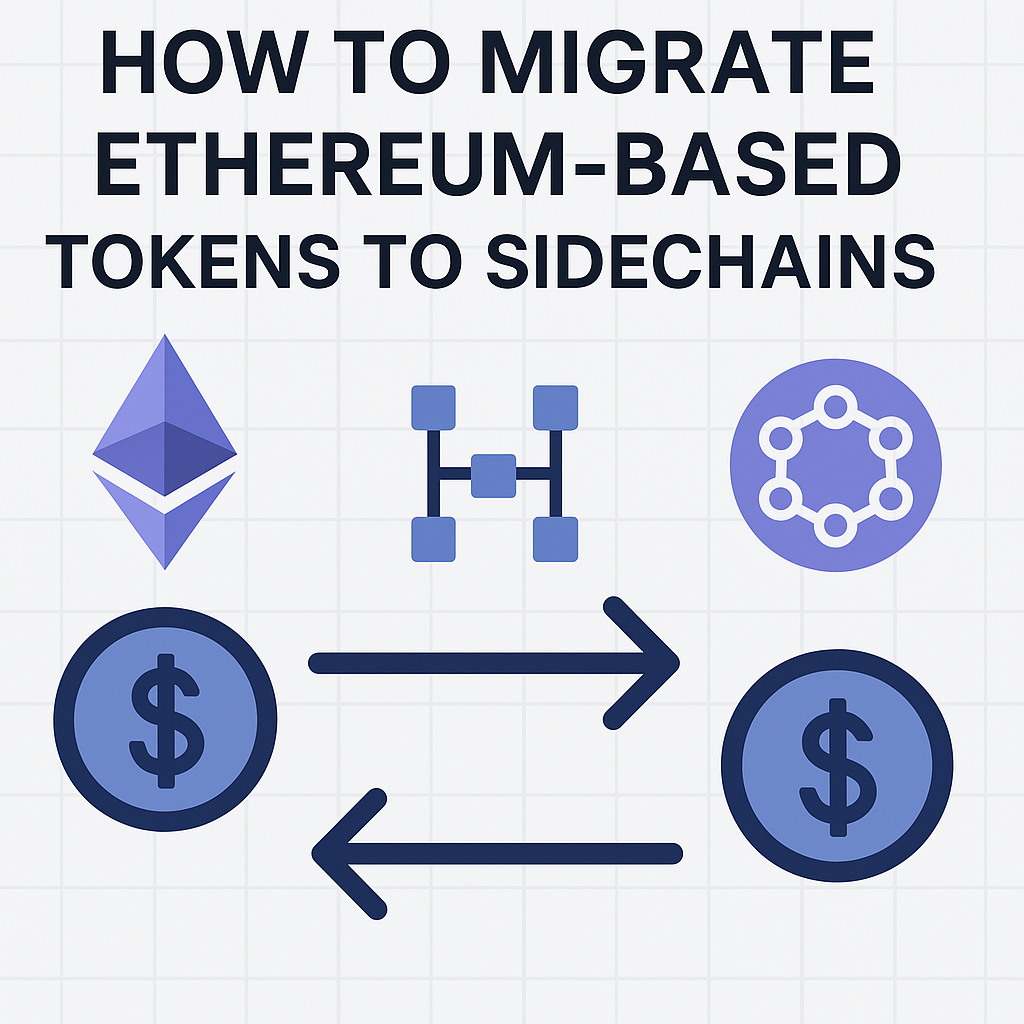In this article, I will explain How To Migrating Ethereum-based Tokens To Sidechains which are important for improving scalability, lowering gas fees, and achieving faster transaction speeds.
With the growth of blockchain ecosystems, knowing how to bridge assets will unlock new dApps, DeFi, and NFT marketplaces. I will guide you through the tools and steps to take along with the risks and opportunities to help you make informed decisions.
What Is Sidechains?
Sidechains are self-governing blockchains that operate simultaneously with a primary blockchain known as the mainnet, offering secure mechanisms for transferring assets and information through chains.
Each sidechain employs its own consensus mechanism; however, it is linked to the main chain via a two-way bridge, enabling token relocation in both directions.
Sidechains enhance scalability, relieve congestion on the main chain, and enable the testing of new features without putting the main blockchain’s security at risk.
How To Migrating Ethereum-based Tokens To Sidechains
Getting Familiar with Side Chains
Side chains are separate blockchains that are linked to Ethereum through two-way bridges. They enable the transfer of tokens as well as cross chain integrations.
Decide on a Side Chain
Considerate and trusted sidechains, for example, Polygon offers Ethereum token migration and participates in fast and cheap transactions.
Utilize a Bridge
Head over to the bridge site (for example: Polygon Bridge). In the Deposit section, choose your token, amount, and hit the transfer button.
Token Transfer Approval
Give permission to the transaction through your wallet (MetaMask for example). Complete the given instructions and will tokens appear in your sidechain wallet after migration.
Addional Information
For further insigth, check out the official Ethereum documentation.
Pros and cons of sidechains
Pros of Sidechains
Scalability: Relieves strain on the main chain by processing transactions externally which helps improve system performance.
Lower Fees: Compared to Layer 1 networks, sidechains usually have lower gas charges.
Customizability: Developers get to change different consensus models, block sizes, and certain characteristics without impacting the mainnet.
EVM Compatibility: Development of dApps is simpler because a lot of sidechains support Ethereum smart contracts.
Interoperability: Cross-chain operability is possible through bridges which transfer assets between chains.
Privacy Options: Certain sidechains give enhanced privacy options such as zero-knowledge proofs or confidential transactions.
Cons of Sidechains
Security Risks: Not only do sidechains lack the main chains security, but they also have to take care of their own security.
Decentralization Trade-offs: A number of sidechains focusing on speed tend to depend on fewer validators which lowers the degree of decentralization.
Complexity: Advanced knowledge and tools are needed to set up and maintain sidechains.
Trust Assumptions: For bridges or validators, users might need to trust which carries the risk of centralization.
Fragmentation: It is possible to have liquidity and user fragmentation across multiple ecosystems due to the existence of many sidechains.
Security and Best Practices for Migrating Ethereum-Based Tokens to Sidechains
| Best Practice | Details |
|---|---|
| Use Official Bridges Only | Always use the official bridge associated with the sidechain (e.g., Polygon Bridge, Arbitrum Bridge) to avoid phishing or scams. |
| Verify URLs and Smart Contracts | Double-check URLs and contract addresses before initiating any transfer. Avoid clicking bridge links from unofficial sources. |
| Use a Trusted Wallet | Use reputable wallets like MetaMask or Trust Wallet with updated software to reduce the risk of exploits or compatibility issues. |
| Start with a Small Transfer | Test the bridge process with a small amount first to verify everything is working correctly before sending larger amounts. |
| Check Token Support | Ensure the token is supported on the destination sidechain. Unsupported tokens may be lost or inaccessible. |
| Watch for Gas Fees | Be prepared to pay gas fees on Ethereum for approvals and bridging. Avoid bridging during network congestion to save on fees. |
| Enable 2FA Where Possible | Use two-factor authentication (2FA) on wallets and accounts connected to exchanges or bridges to increase security. |
| Monitor the Bridge Transaction | Use the bridge’s dashboard or blockchain explorer to track your transaction and confirm successful migration. |
| Keep Private Keys Safe | Never share your seed phrase or private keys. Store them offline in a secure location. |
Common Challenges in Token Migration
Transactions Stuck
Cause: Network congestion or insufficient gas fees.
Fix: Monitor the transaction on Etherscan or the relevant sidechain explorer. If it’s been too long, attempt to either speed it up or cancel and resubmit with higher gas fees.
Token Does not Reflect in Wallet
Cause: The token does not get auto-imported on the respective sidechain.
Fix: Go to the sidechain explorer e.g. Polygonscan or Arbiscan to manually add the token using its contract address.
Delay or Failure with Bridge
Cause: Congestion, downtimes, or issues with the smart contract of the bridge.
Fix: Check discord or the official status page of the bridge. Wait some time then retry, or use other bridges such as Synapse or Across Protocol. Avoid peak hours while bridging.
Wrong Network Parameters
Cause: Wallet linked to wrong sidechain.
Fix: Change your wallet’s network manually. Chainlist.org helps auto-configure networks like Polygon and Arbitrum which is useful.
Confusion with Wrapped Tokens as a Result
Cause: Receiving wrapped versions of tokens (e.g. wETH instead of ETH).
Fix: Understand the token’s format on the sidechain. If necessary, use decentralized exchanges like Uniswap and SushiSwap to swap those wrapped tokens.
Missing Authorization Step
Cause: Token was not approved for bridging.
Change: Review the bridge interface and give token approval prior to the transfer retry.
Phishing Schemes or Counterfeit Bridges
Reason: Clicking on harmful URLs.
Solution: Make sure to validate URLs. Save official bridge site URLs as bookmarks to prevent clicking links from unknown sources.
Use Cases After Token Migration to Sidechains
1. DeFi Applications
- You can now trade tokens on DEXs such as QuickSwap (Polygon) or HoneySwap (Gnosis).
- Provide liquidity and earn yield with lower gas costs and spend less on gas.
- Leveraging sidechains allows you to use lending protocols Aave or Compound.
2. NFT Marketplaces:
- Minting, purchasing, and selling NFTs now comes with drastically lower fees.
- Sidechain-based assets are accepted by OpenSea (Polygon) and TofuNFT (Gnosis).
- Well suited for drops and collectibles around gaming NFTs and other high-volume NFTs.
3. Gaming & Metaverse
- Low latency API allows for in-game purchases and digital asset transfer.
- Sidechains are used by Decentraland and Aavegotchi for smoother gameplay.
- Enables tokenized rewards and microtransactions.
4. DAO Governance
- With migrated tokens, users can vote on proposals within DAOs hosted on sidechains.
- Faster execution of governance actions.
- Lower costs encourage broad-based participation, which improves turnout.
5. Stable Payments & Micropayments
- Quick and inexpensive payments using USD-pegged stablecoins like USDC or DAI.
- Great for tipping, subscription payments, and pay-per-use models.
- xDai and similar sidechains focus on stable and cost-effective transactions.
6. Cross-Chain Arbitrage
- Exploit the value disparity of different chains.
- Shift assets between ecosystems using bridges for rapid transfers.
- Multi-chain arbitrage strategies are supported by Synapse and Across Protocol.
7. Custom dApp Deployments
- Create dApps with bespoke consensus and configurations tailored to performance requirements.
- Experimentation is possible on sidechains without disrupting the Ethereum mainnet.
- Ideal for startups and enterprise solutions.
Conclusion
Transferring Ethereum tokens to sidechains is a tactical shift that enables quicker transactions, lower costs, and increased interoperability within the Web3 ecosystem. A well-defined migration strategy ensures asset movement agility and confidence by selecting the appropriate sidechain, employing trusted bridges, and using verified security protocols.
Sidechains are not merely technological appendages; they foster robust ecosystems capable of hosting DeFi protocols, NFT marketplaces, gaming centers, DAOs, and more. While issues such as bridge wait times or token identification may arise, overcoming these challenges is possible with prudent problem-solving and modern resources.
Bridging to sidechains gives both users and developers the freedom to bypass Ethereum’s congestion constraints while still utilizing its foundational framework. Increasing mastery of these migrations enriches skills essential for multichain developments.
FAQ
What is a sidechain in blockchain?
A sidechain is an independent blockchain that runs parallel to a main chain (like Ethereum) and is connected via a bridge. It allows for faster, cheaper transactions while maintaining interoperability with the main network.
Is bridging the same as migrating?
Yes, in most cases. Bridging refers to the technical process of transferring tokens from Ethereum to a sidechain. Migration is a broader term that includes preparation, bridging, and post-transfer actions.
What happens to my tokens during migration?
Tokens are typically locked on Ethereum and minted as pegged or wrapped versions on the sidechain. When you bridge back, the wrapped tokens are burned and the originals unlocked.
Can I use my tokens immediately after bridging?
Yes, once the transaction is confirmed and the tokens appear in your wallet on the sidechain. You may need to manually import the token using its contract address.









